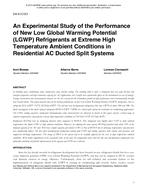
DA-13-C013 — An Experimental Study of the Performance of New Low Global Warming Potential (LGWP) Refrigerants at Extreme High Temperature Ambient Conditions in Residential AC Ducted Split Systems
- Comments Off on DA-13-C013 — An Experimental Study of the Performance of New Low Global Warming Potential (LGWP) Refrigerants at Extreme High Temperature Ambient Conditions in Residential AC Ducted Split Systems
- ASHRAE
In building space conditioning vapor compression cycles provide cooling. The working fluid is often a refrigerant that has good thermal and transport properties and high volumetric capacity for AC applications, but it might have unfavorable effects on the environment in case of leakage. Energy conservation and environmental concerns are the core reasons for the tremendous growth of high performance and environmentally friendly heat transfer fluids. This paper presents data of the thermal performance of four Low Global Warming Potential (LGWP) refrigerants, that is, refrigerant R32 (GWP . 675), R1234yf (GWP . 4) and two new developmental refrigerants that have GWPs of about 300 and 500. The fluids investigated in this work replaced refrigerant R410A (GWP . 2088) in a ducted split system for residential air conditioning applications. The COPs, cooling capacities, refrigerants thermodynamic cycles characteristics are discussed in details in this paper and for a broad range of ambient temperatures; especially for extreme high temperature conditions of 110° and 115°F (43° and 46°C).
Refrigerant R1234yf had an intriguing behavior when compared to R410A. This refrigerant had slightly lower COP at mild ambient temperatures but higher COPs at high ambient conditions. However, by adopting the same system, R1234yf provided only about 54% of the nominal capacity of the AC unit. R32 had a higher capacity and similar COPs as that of R410A but its discharge temperatures and pressures were significantly higher. The two novel developmental refrigerants yielded good COPs and cooling capacities with similar cycle pressures and compressor discharge temperatures. The charge of DR-4 in the system had to be carefully adjusted for the tests at high temperature ambient conditions. With minor adjustments of the expansion valve of the unit, the refrigeration cycles with the two new developmental refrigerants were optimally controlled and further improvements of the capacity and COPs were achieved.
Citation: ASHRAE Conference Papers, Dallas, TX.
Product Details
- Published:
- 2013
- Number of Pages:
- 8
- File Size:
- 1 file , 1.7 MB
- Product Code(s):
- D-DA-13-C013

